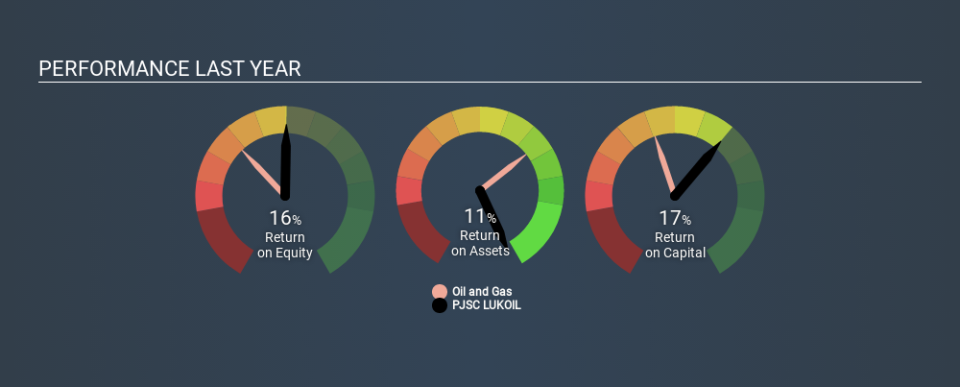PJSC LUKOIL (MCX:LKOH) Is Employing Capital Very Effectively

Today we'll look at PJSC LUKOIL (MCX:LKOH) and reflect on its potential as an investment. Specifically, we're going to calculate its Return On Capital Employed (ROCE), in the hopes of getting some insight into the business.
First, we'll go over how we calculate ROCE. Then we'll compare its ROCE to similar companies. Finally, we'll look at how its current liabilities affect its ROCE.
Return On Capital Employed (ROCE): What is it?
ROCE is a measure of a company's yearly pre-tax profit (its return), relative to the capital employed in the business. Generally speaking a higher ROCE is better. Ultimately, it is a useful but imperfect metric. Renowned investment researcher Michael Mauboussin has suggested that a high ROCE can indicate that 'one dollar invested in the company generates value of more than one dollar'.
So, How Do We Calculate ROCE?
Analysts use this formula to calculate return on capital employed:
Return on Capital Employed = Earnings Before Interest and Tax (EBIT) ÷ (Total Assets - Current Liabilities)
Or for PJSC LUKOIL:
0.17 = ₽797b ÷ (₽5.9t - ₽1.2t) (Based on the trailing twelve months to December 2019.)
So, PJSC LUKOIL has an ROCE of 17%.
See our latest analysis for PJSC LUKOIL
Does PJSC LUKOIL Have A Good ROCE?
ROCE can be useful when making comparisons, such as between similar companies. PJSC LUKOIL's ROCE appears to be substantially greater than the 11% average in the Oil and Gas industry. I think that's good to see, since it implies the company is better than other companies at making the most of its capital. Separate from PJSC LUKOIL's performance relative to its industry, its ROCE in absolute terms looks satisfactory, and it may be worth researching in more depth.
We can see that, PJSC LUKOIL currently has an ROCE of 17% compared to its ROCE 3 years ago, which was 9.8%. This makes us think the business might be improving. The image below shows how PJSC LUKOIL's ROCE compares to its industry, and you can click it to see more detail on its past growth.
It is important to remember that ROCE shows past performance, and is not necessarily predictive. ROCE can be misleading for companies in cyclical industries, with returns looking impressive during the boom times, but very weak during the busts. ROCE is only a point-in-time measure. Remember that most companies like PJSC LUKOIL are cyclical businesses. Since the future is so important for investors, you should check out our free report on analyst forecasts for PJSC LUKOIL.
Do PJSC LUKOIL's Current Liabilities Skew Its ROCE?
Short term (or current) liabilities, are things like supplier invoices, overdrafts, or tax bills that need to be paid within 12 months. The ROCE equation subtracts current liabilities from capital employed, so a company with a lot of current liabilities appears to have less capital employed, and a higher ROCE than otherwise. To counter this, investors can check if a company has high current liabilities relative to total assets.
PJSC LUKOIL has current liabilities of ₽1.2t and total assets of ₽5.9t. As a result, its current liabilities are equal to approximately 20% of its total assets. Current liabilities are minimal, limiting the impact on ROCE.
Our Take On PJSC LUKOIL's ROCE
This is good to see, and with a sound ROCE, PJSC LUKOIL could be worth a closer look. PJSC LUKOIL looks strong on this analysis, but there are plenty of other companies that could be a good opportunity . Here is a free list of companies growing earnings rapidly.
PJSC LUKOIL is not the only stock insiders are buying. So take a peek at this free list of growing companies with insider buying.
If you spot an error that warrants correction, please contact the editor at editorial-team@simplywallst.com. This article by Simply Wall St is general in nature. It does not constitute a recommendation to buy or sell any stock, and does not take account of your objectives, or your financial situation. Simply Wall St has no position in the stocks mentioned.
We aim to bring you long-term focused research analysis driven by fundamental data. Note that our analysis may not factor in the latest price-sensitive company announcements or qualitative material. Thank you for reading.

 Yahoo Finance
Yahoo Finance 
